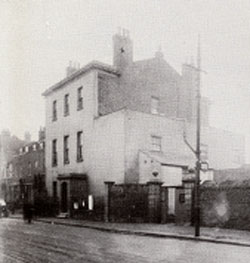Teddington
The Manor House, The Grove and other houses demolished in the 19th and 20th c

In 1800 the population of Teddington was under 700, in 100 houses. Although some were substantial they were not palatial. The number of houses had probably doubled by the 1860s, but the population was still only just over 1000. In 1861 the Manor of Teddington, which consisted of nearly half the parish, was sold for the development of desirable villas and to assist this development the railway arrived in 1863. By the end of the century many large and small older houses had been demolished. A number of large houses were built after 1870, and some remain today, but several have been replaced with blocks of flats.
The original centre of the village was the High Street from St Mary's Church to the village pond just to the west of Elmfield House. The Manor House (above) was opposite the church in Twickenham Road and had probably been built in about 1600. The house, possibly rebuilt or refurbished in 1800, was demolished in 1895.

Along Twickenham Road was The Grove built in 1760 for Moses Franks, a wealthy Jewish merchant who died in 1789. The house was then occupied by John Walter, the founder of The Times. It was acquired by Shell in the 1920s and was replaced by the Grove Estate

In 1683 Charles Duncombe, one of the richest men in England, acquired a property opposite the church, from The Marquis of Winchester, which he named Teddington Place. He refurbished the house with ceilings painted by Verrio and carvings by Grinling Gibbons. St Alban's Church, now the Landmark Centre, was built in part of the grounds in 1887 and the house was renamed Udney Hall. It was demolished in 1946 to form Udney Hall Gardens. On the west corner of Kingston Lane was Udney House built in about 1786. It was demolished in 1899. The Old House, or Queen Elizabeth's Hunting Lodge, was on the site of Udney Park Road. It is said that it was built in 1565. A large farm was attached to the house, which was pulled down in 1875.

A little further west was Bridgeman House. Sir Orlando Bridgeman, Lord Keeper of the Seal of Charles II, is believed to have lived here in the 1660s. The probable successor to this property was demolished in 1911. To the west of Field Lane was The Cedars, which was built in 1800 and demolished at the end of the century.

There were a number of large houses on the north side of the High Street next to Elmfield House. This house was built in the 1690s. It is still standing, owned by the Council but is no longer a residence. Next to this was Percy House, occupied by Dr Stephen Hales the curate of St Mary's Church from 1709 to 1761. Next door was Teddington House, built about 1750. It was occupied by Lt General George Vialls in the 1890s, the youngest son of Thomas Vialls of Radnor House in Twickenham. These two houses had been demolished by 1910. Elmfield Avenue and a cinema were opened on the site of Teddington House. A large house, Teddington Lodge, stood on the corner of Park Road and Park Lane. This was demolished in 1950 to make way for the new police station.
There were no buildings in Broad Street in 1800 although there were houses in Middle Lane backing on to Broad Street and in Park Lane, including the almshouses, built in 1739 and demolished in about 1950. Elleray Villa was built by 1820 on the corner of North Lane with an entrance in Broad Street. The house was demolished in about 1890 and the site crossed by Elleray Road. There was a house round the corner in Stanley Road in 1800. It is thought that this was the house called Maud Cottage, later called The Hollies or the Old Hollies. The house was demolished in 1965 to make way for the redevelopment of the land between Somerset Road and Walpole Road.
Several houses on the river side of Broom Road were built in the 1850s. These included Weir House, the former Thames Television Studios and Rock Hall, Dunbar House, Weirbank and New Broom Hall. These four houses were acquired by the Shell Company in the 1920s and were used as the Lensbury, their sports club, until they were all demolished in the 1930s and the new building erected. They also acquired Old Broom Hall which was alongside the river, built in about 1760. Several houses had been built next to the border with Hampton Wick by the 1820s but all have been demolished to make way for modern estates. A large house, Broom Hill, was built in about 1820 between Broom Road and Kingston Road to the north of the land which later became Normansfield. This house and its associated farm were demolished when Holmesdale Road was opened in the 1880s.




